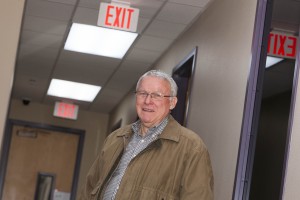 CPS Energy’s electric reliability is within the top tier of the industry, its employees have increased safety to a record high for the second year in a row, and customer satisfaction remains high.
CPS Energy’s electric reliability is within the top tier of the industry, its employees have increased safety to a record high for the second year in a row, and customer satisfaction remains high.
That’s what the San Antonio City Council heard at its April 3 work session from CPS Energy CEO Doyle Beneby, who also offered an update on the state of the energy industry and the city-owned utility’s overall strategic plan.
Beneby also touched on the utility’s finances, which remain strong, and the continued job creation from its New Energy Economy partners.
“I can’t point to any one factor as the driver of CPS Energy’s success,” Beneby said. “It takes a committed team of employees doing a hundred different things well to get these kinds of results. And when we deliver the basics reliably, it gives us an opportunity to look for other ways to be of value to our customers—through economic development and support for education initiatives.”
Diversification and risk management remain the cornerstone of CPS Energy policy, Beneby said. That includes continuing to reduce the carbon intensity of the utility’s generation fleet, by moving away from unscrubbed coal and increasing the use of natural gas, clean coal and solar power.
CPS Energy also continues to invest in innovative technologies, such as LED lighting, electrical grid upgrades and demand management technologies. Those investments all have a strong economic development component, as CPS Energy continues to leverage its investments to bring good-paying, clean energy jobs to the region.
Customers continue to give the utility high marks, Beneby told the council.
Since 2009, customer satisfaction has inched upwards from 79 percent to 81 percent, according to the annual Residential Customer Satisfaction Surveys. Beneby has set a goal of 83 percent satisfaction by 2015, he told the council.
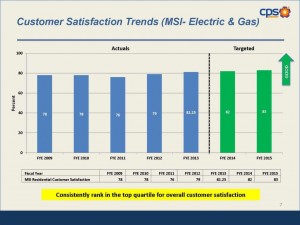
CPS Energy ranks number one in overall customer satisfaction among large southern utilities, according to J.D. Power and Associates, topping a list that includes Florida Power & Light, Alabama Power, Oklahoma Gas & Electric and South Carolina Electric & Gas.
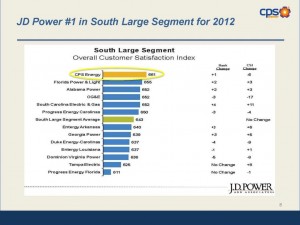
Customer satisfaction has dipped recently, as CPS Energy deals with a temporary increase in estimated billing, the industry-wide practice of estimating some bills, then adjusting them to the actual meter reading at a later date.
That has led to an increase in customer service calls and longer wait times for those trying to sort out their bills.
CPS Energy has since hired additional readers and has sped up the implementation of meters which can be read remotely, meaning readers don’t have to go on a customer’s property to get a reading.
“And to help with high call volumes, we’re encouraging our customers to use more of our online service features, especially during the upcoming summer months when we experience the highest volume of customer calls,” said Maria Koudouris, senior vice president of customer service.
Customer satisfaction remains high when it comes to reliability. Both the length and frequency of outages has declined; in 2009, the average length of interruption was more than two hours; last year it was just over an hour, putting CPS Energy in the top ten percent for utility reliability.
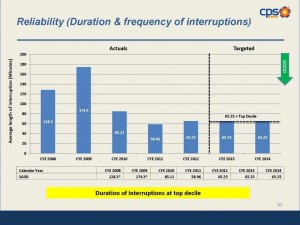
For all the good news, Beneby is perhaps most proud of CPS Energy’s safety record. He has consistently said that he considers safety — getting employees home safely to their families every night — to be his top priority.
For the second year in a row, CPS Energy employees have met the challenge, resulting in the best safety performance in the company’s history. Reported safety incidents have dropped from 120 in 2009 to 48 last year. Beneby has set even more stringent goals, to reduce incidents even more by 2015.
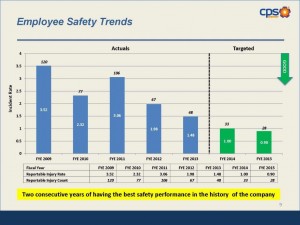
Turning to the company’s financials, Beneby told councilmembers CPS Energy is recognized as having the premier credit rating in the industry by Bank of America/Merrill Lynch, a position bolstered by a continued focus on cost efficiency and process improvements within the company.
As a result, operations and maintenance costs per CPS Energy customer has dropped, from $368 to $345 per person, with a goal of $333 per person by 2015. At the same time, employees continue to work more efficiently. That has resulted in a leaner workforce, from a high of almost 4,300 in 2001 to about 3,400 today.
Beneby also highlighted CPS Energy’s stepped-up commitment to economic development. The utility’s New Energy Economy partners, which include OCI Solar Power, GreenStar, Silver Spring Network and Consert, among others, have made $88 million in investments in the San Antonio region to date, including the creation of 154 jobs and $1.5 million that has been donated to local educational initiatives.
Those partners are on track to meet their commitments to create more than 1,000 jobs by 2018, Beneby said, with investments topping $974 million.
Councilman Reed Williams, a former energy industry executive, said he was pleased by what he heard.
“I think we’re in a great position,” he said, referencing the utility’s increased use of natural gas as part of its effort to diversify fuel sources. “Keeping costs down, safety up — these are good things.”

 When CPS Energy approached Doyle Jennings of
When CPS Energy approached Doyle Jennings of 